Uber Case Study: Analyzing Business Model, Growth, and Challenges
VerifiedAdded on 2022/11/25
|47
|9332
|414
Case Study
AI Summary
This case study report examines Uber's business model, growth strategies, and competitive challenges, providing a comprehensive analysis of the ride-sharing giant. The report begins with an executive summary and table of contents, followed by an introduction outlining the project's rationale, objectives, and research questions. A literature review explores Uber's car services, business model, SWOT analysis, competition, use of emergent technologies, growth strategy, and the challenges facing the ride-sharing industry. The research methodology details the method outline, research philosophy, approach, data collection, sample size, data analysis plans, and ethical considerations. Findings and analysis include descriptive statistics, correlation, and regression analysis. The report concludes with recommendations and conclusions. Appendices include a questionnaire and a screenshot of a Google Form used in the research. The assignment addresses Uber's business model, competitive situation, growth strategy, impediments to growth, and critical challenges faced by the ride-sharing industry. It identifies innovative solutions using information systems and provides recommendations for future improvements.
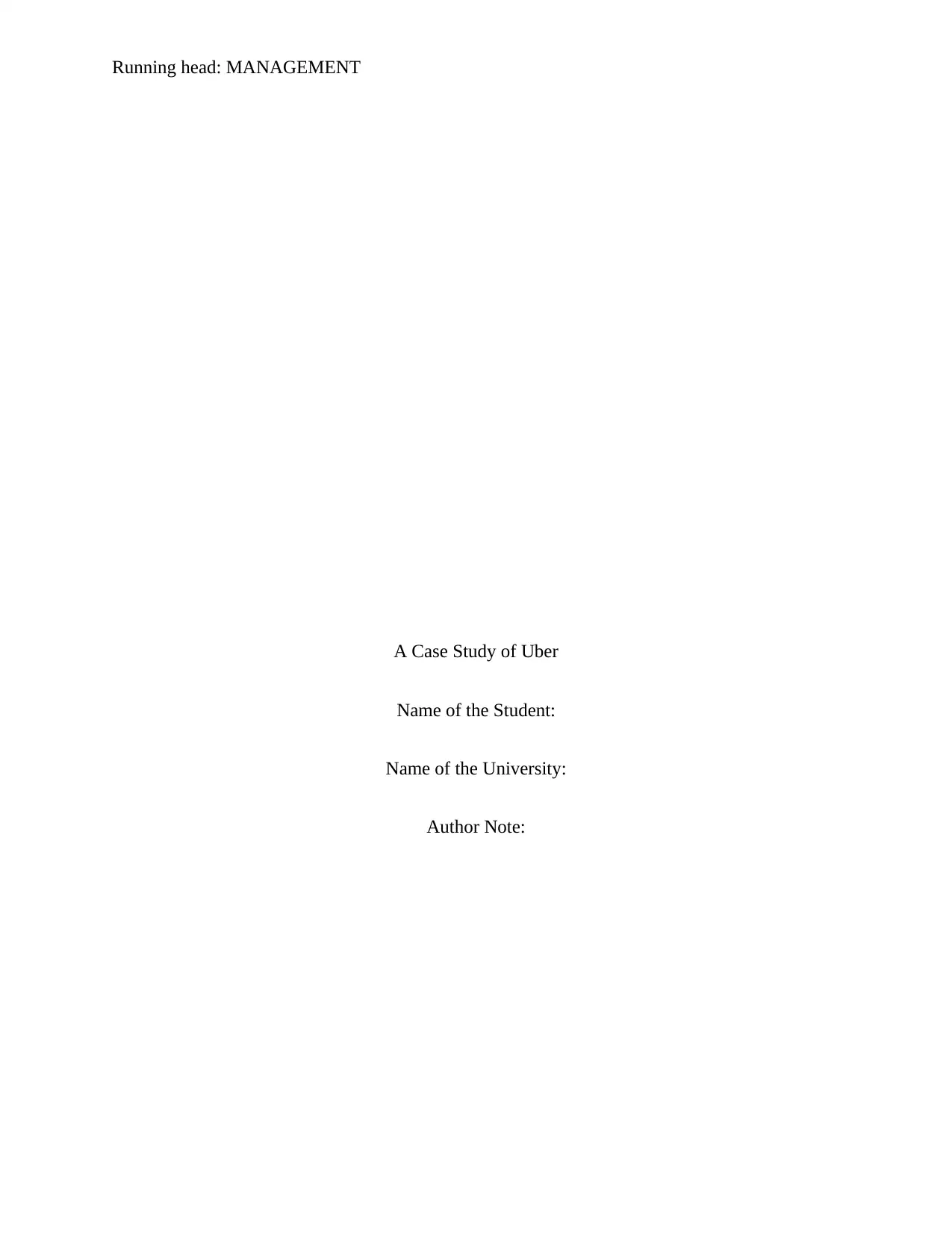
Running head: MANAGEMENT
A Case Study of Uber
Name of the Student:
Name of the University:
Author Note:
A Case Study of Uber
Name of the Student:
Name of the University:
Author Note:
Paraphrase This Document
Need a fresh take? Get an instant paraphrase of this document with our AI Paraphraser
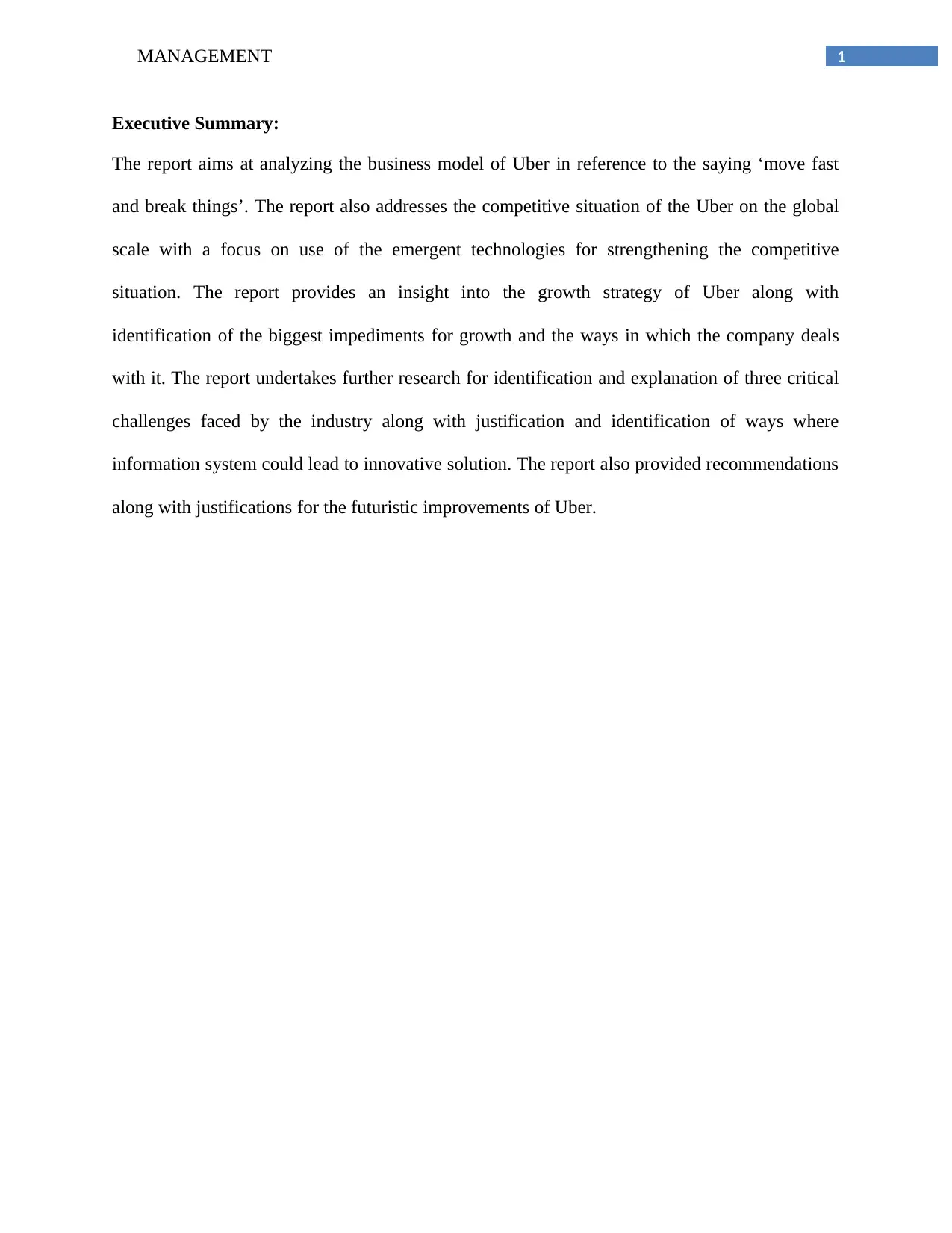
1MANAGEMENT
Executive Summary:
The report aims at analyzing the business model of Uber in reference to the saying ‘move fast
and break things’. The report also addresses the competitive situation of the Uber on the global
scale with a focus on use of the emergent technologies for strengthening the competitive
situation. The report provides an insight into the growth strategy of Uber along with
identification of the biggest impediments for growth and the ways in which the company deals
with it. The report undertakes further research for identification and explanation of three critical
challenges faced by the industry along with justification and identification of ways where
information system could lead to innovative solution. The report also provided recommendations
along with justifications for the futuristic improvements of Uber.
Executive Summary:
The report aims at analyzing the business model of Uber in reference to the saying ‘move fast
and break things’. The report also addresses the competitive situation of the Uber on the global
scale with a focus on use of the emergent technologies for strengthening the competitive
situation. The report provides an insight into the growth strategy of Uber along with
identification of the biggest impediments for growth and the ways in which the company deals
with it. The report undertakes further research for identification and explanation of three critical
challenges faced by the industry along with justification and identification of ways where
information system could lead to innovative solution. The report also provided recommendations
along with justifications for the futuristic improvements of Uber.
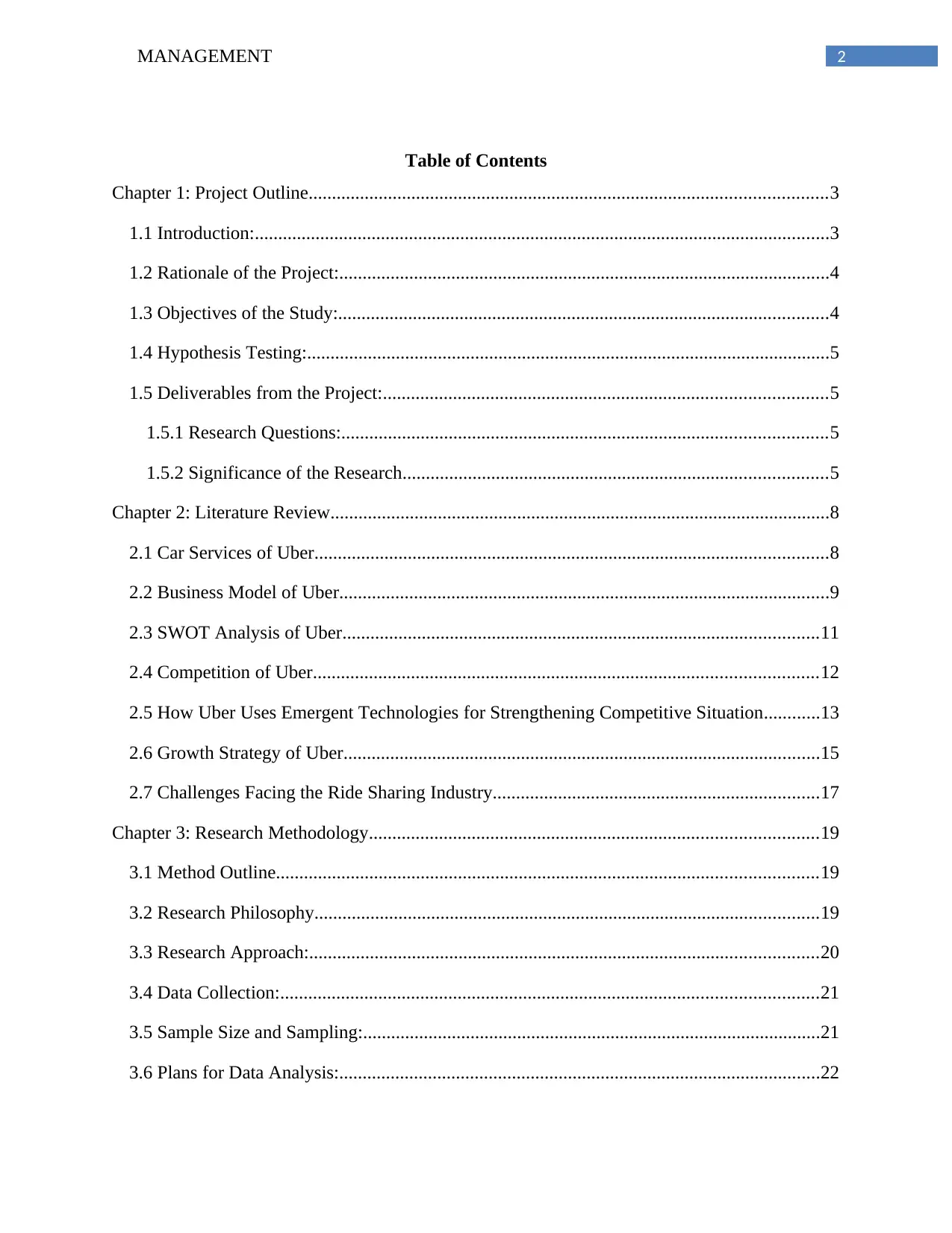
2MANAGEMENT
Table of Contents
Chapter 1: Project Outline...............................................................................................................3
1.1 Introduction:...........................................................................................................................3
1.2 Rationale of the Project:.........................................................................................................4
1.3 Objectives of the Study:.........................................................................................................4
1.4 Hypothesis Testing:................................................................................................................5
1.5 Deliverables from the Project:...............................................................................................5
1.5.1 Research Questions:........................................................................................................5
1.5.2 Significance of the Research...........................................................................................5
Chapter 2: Literature Review...........................................................................................................8
2.1 Car Services of Uber..............................................................................................................8
2.2 Business Model of Uber.........................................................................................................9
2.3 SWOT Analysis of Uber......................................................................................................11
2.4 Competition of Uber............................................................................................................12
2.5 How Uber Uses Emergent Technologies for Strengthening Competitive Situation............13
2.6 Growth Strategy of Uber......................................................................................................15
2.7 Challenges Facing the Ride Sharing Industry......................................................................17
Chapter 3: Research Methodology................................................................................................19
3.1 Method Outline....................................................................................................................19
3.2 Research Philosophy............................................................................................................19
3.3 Research Approach:.............................................................................................................20
3.4 Data Collection:...................................................................................................................21
3.5 Sample Size and Sampling:..................................................................................................21
3.6 Plans for Data Analysis:.......................................................................................................22
Table of Contents
Chapter 1: Project Outline...............................................................................................................3
1.1 Introduction:...........................................................................................................................3
1.2 Rationale of the Project:.........................................................................................................4
1.3 Objectives of the Study:.........................................................................................................4
1.4 Hypothesis Testing:................................................................................................................5
1.5 Deliverables from the Project:...............................................................................................5
1.5.1 Research Questions:........................................................................................................5
1.5.2 Significance of the Research...........................................................................................5
Chapter 2: Literature Review...........................................................................................................8
2.1 Car Services of Uber..............................................................................................................8
2.2 Business Model of Uber.........................................................................................................9
2.3 SWOT Analysis of Uber......................................................................................................11
2.4 Competition of Uber............................................................................................................12
2.5 How Uber Uses Emergent Technologies for Strengthening Competitive Situation............13
2.6 Growth Strategy of Uber......................................................................................................15
2.7 Challenges Facing the Ride Sharing Industry......................................................................17
Chapter 3: Research Methodology................................................................................................19
3.1 Method Outline....................................................................................................................19
3.2 Research Philosophy............................................................................................................19
3.3 Research Approach:.............................................................................................................20
3.4 Data Collection:...................................................................................................................21
3.5 Sample Size and Sampling:..................................................................................................21
3.6 Plans for Data Analysis:.......................................................................................................22
⊘ This is a preview!⊘
Do you want full access?
Subscribe today to unlock all pages.

Trusted by 1+ million students worldwide
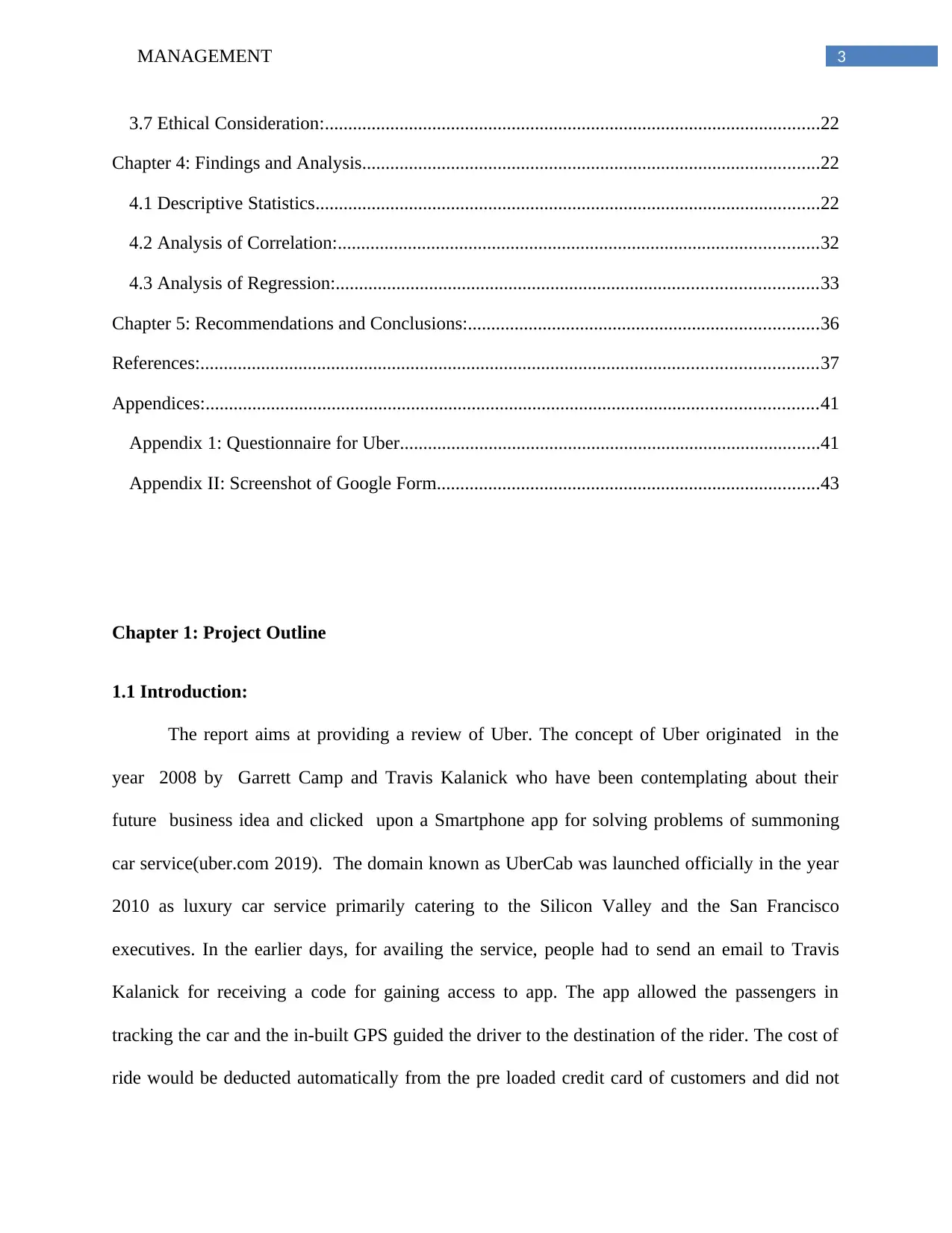
3MANAGEMENT
3.7 Ethical Consideration:..........................................................................................................22
Chapter 4: Findings and Analysis..................................................................................................22
4.1 Descriptive Statistics............................................................................................................22
4.2 Analysis of Correlation:.......................................................................................................32
4.3 Analysis of Regression:.......................................................................................................33
Chapter 5: Recommendations and Conclusions:...........................................................................36
References:....................................................................................................................................37
Appendices:...................................................................................................................................41
Appendix 1: Questionnaire for Uber..........................................................................................41
Appendix II: Screenshot of Google Form..................................................................................43
Chapter 1: Project Outline
1.1 Introduction:
The report aims at providing a review of Uber. The concept of Uber originated in the
year 2008 by Garrett Camp and Travis Kalanick who have been contemplating about their
future business idea and clicked upon a Smartphone app for solving problems of summoning
car service(uber.com 2019). The domain known as UberCab was launched officially in the year
2010 as luxury car service primarily catering to the Silicon Valley and the San Francisco
executives. In the earlier days, for availing the service, people had to send an email to Travis
Kalanick for receiving a code for gaining access to app. The app allowed the passengers in
tracking the car and the in-built GPS guided the driver to the destination of the rider. The cost of
ride would be deducted automatically from the pre loaded credit card of customers and did not
3.7 Ethical Consideration:..........................................................................................................22
Chapter 4: Findings and Analysis..................................................................................................22
4.1 Descriptive Statistics............................................................................................................22
4.2 Analysis of Correlation:.......................................................................................................32
4.3 Analysis of Regression:.......................................................................................................33
Chapter 5: Recommendations and Conclusions:...........................................................................36
References:....................................................................................................................................37
Appendices:...................................................................................................................................41
Appendix 1: Questionnaire for Uber..........................................................................................41
Appendix II: Screenshot of Google Form..................................................................................43
Chapter 1: Project Outline
1.1 Introduction:
The report aims at providing a review of Uber. The concept of Uber originated in the
year 2008 by Garrett Camp and Travis Kalanick who have been contemplating about their
future business idea and clicked upon a Smartphone app for solving problems of summoning
car service(uber.com 2019). The domain known as UberCab was launched officially in the year
2010 as luxury car service primarily catering to the Silicon Valley and the San Francisco
executives. In the earlier days, for availing the service, people had to send an email to Travis
Kalanick for receiving a code for gaining access to app. The app allowed the passengers in
tracking the car and the in-built GPS guided the driver to the destination of the rider. The cost of
ride would be deducted automatically from the pre loaded credit card of customers and did not
Paraphrase This Document
Need a fresh take? Get an instant paraphrase of this document with our AI Paraphraser
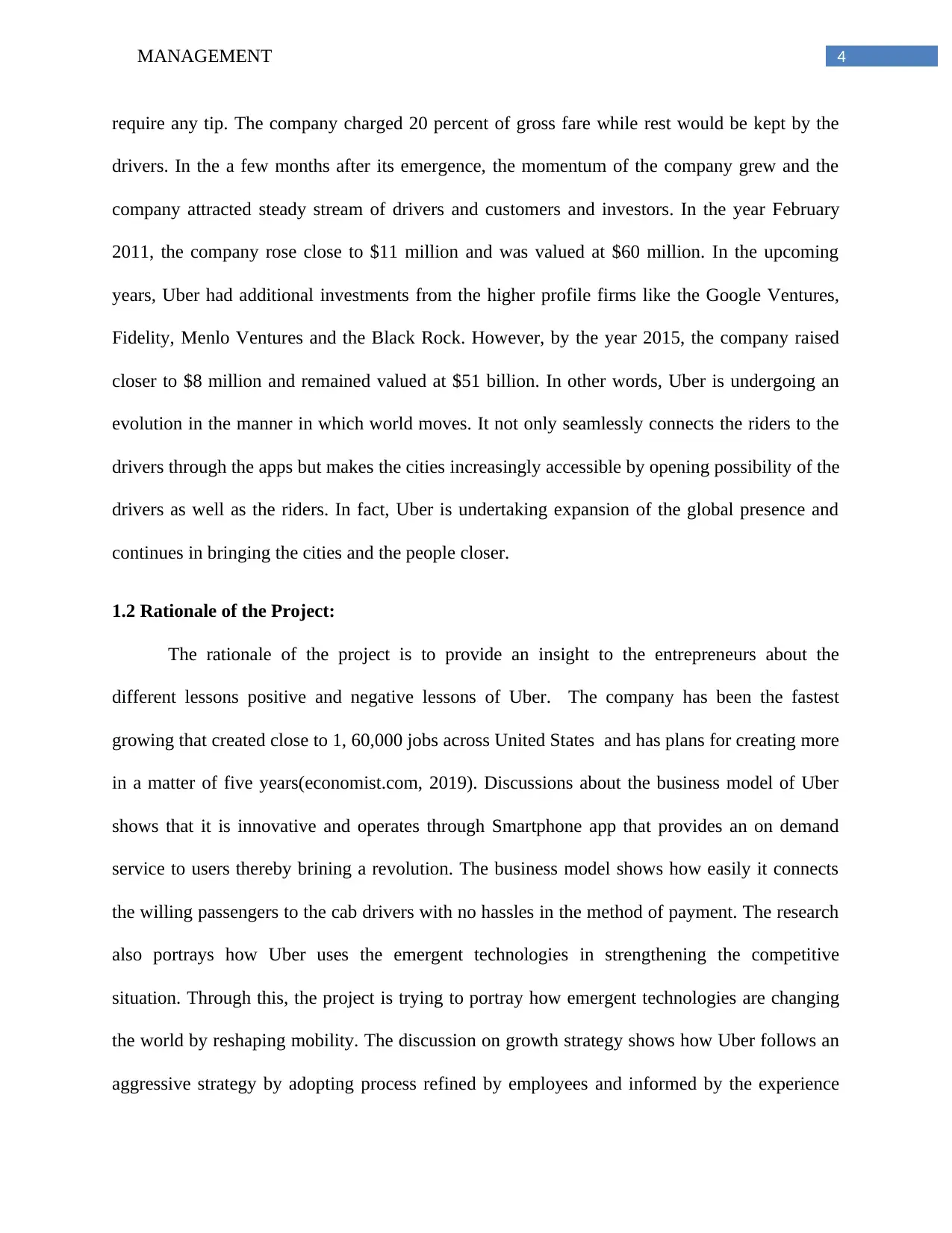
4MANAGEMENT
require any tip. The company charged 20 percent of gross fare while rest would be kept by the
drivers. In the a few months after its emergence, the momentum of the company grew and the
company attracted steady stream of drivers and customers and investors. In the year February
2011, the company rose close to $11 million and was valued at $60 million. In the upcoming
years, Uber had additional investments from the higher profile firms like the Google Ventures,
Fidelity, Menlo Ventures and the Black Rock. However, by the year 2015, the company raised
closer to $8 million and remained valued at $51 billion. In other words, Uber is undergoing an
evolution in the manner in which world moves. It not only seamlessly connects the riders to the
drivers through the apps but makes the cities increasingly accessible by opening possibility of the
drivers as well as the riders. In fact, Uber is undertaking expansion of the global presence and
continues in bringing the cities and the people closer.
1.2 Rationale of the Project:
The rationale of the project is to provide an insight to the entrepreneurs about the
different lessons positive and negative lessons of Uber. The company has been the fastest
growing that created close to 1, 60,000 jobs across United States and has plans for creating more
in a matter of five years(economist.com, 2019). Discussions about the business model of Uber
shows that it is innovative and operates through Smartphone app that provides an on demand
service to users thereby brining a revolution. The business model shows how easily it connects
the willing passengers to the cab drivers with no hassles in the method of payment. The research
also portrays how Uber uses the emergent technologies in strengthening the competitive
situation. Through this, the project is trying to portray how emergent technologies are changing
the world by reshaping mobility. The discussion on growth strategy shows how Uber follows an
aggressive strategy by adopting process refined by employees and informed by the experience
require any tip. The company charged 20 percent of gross fare while rest would be kept by the
drivers. In the a few months after its emergence, the momentum of the company grew and the
company attracted steady stream of drivers and customers and investors. In the year February
2011, the company rose close to $11 million and was valued at $60 million. In the upcoming
years, Uber had additional investments from the higher profile firms like the Google Ventures,
Fidelity, Menlo Ventures and the Black Rock. However, by the year 2015, the company raised
closer to $8 million and remained valued at $51 billion. In other words, Uber is undergoing an
evolution in the manner in which world moves. It not only seamlessly connects the riders to the
drivers through the apps but makes the cities increasingly accessible by opening possibility of the
drivers as well as the riders. In fact, Uber is undertaking expansion of the global presence and
continues in bringing the cities and the people closer.
1.2 Rationale of the Project:
The rationale of the project is to provide an insight to the entrepreneurs about the
different lessons positive and negative lessons of Uber. The company has been the fastest
growing that created close to 1, 60,000 jobs across United States and has plans for creating more
in a matter of five years(economist.com, 2019). Discussions about the business model of Uber
shows that it is innovative and operates through Smartphone app that provides an on demand
service to users thereby brining a revolution. The business model shows how easily it connects
the willing passengers to the cab drivers with no hassles in the method of payment. The research
also portrays how Uber uses the emergent technologies in strengthening the competitive
situation. Through this, the project is trying to portray how emergent technologies are changing
the world by reshaping mobility. The discussion on growth strategy shows how Uber follows an
aggressive strategy by adopting process refined by employees and informed by the experience
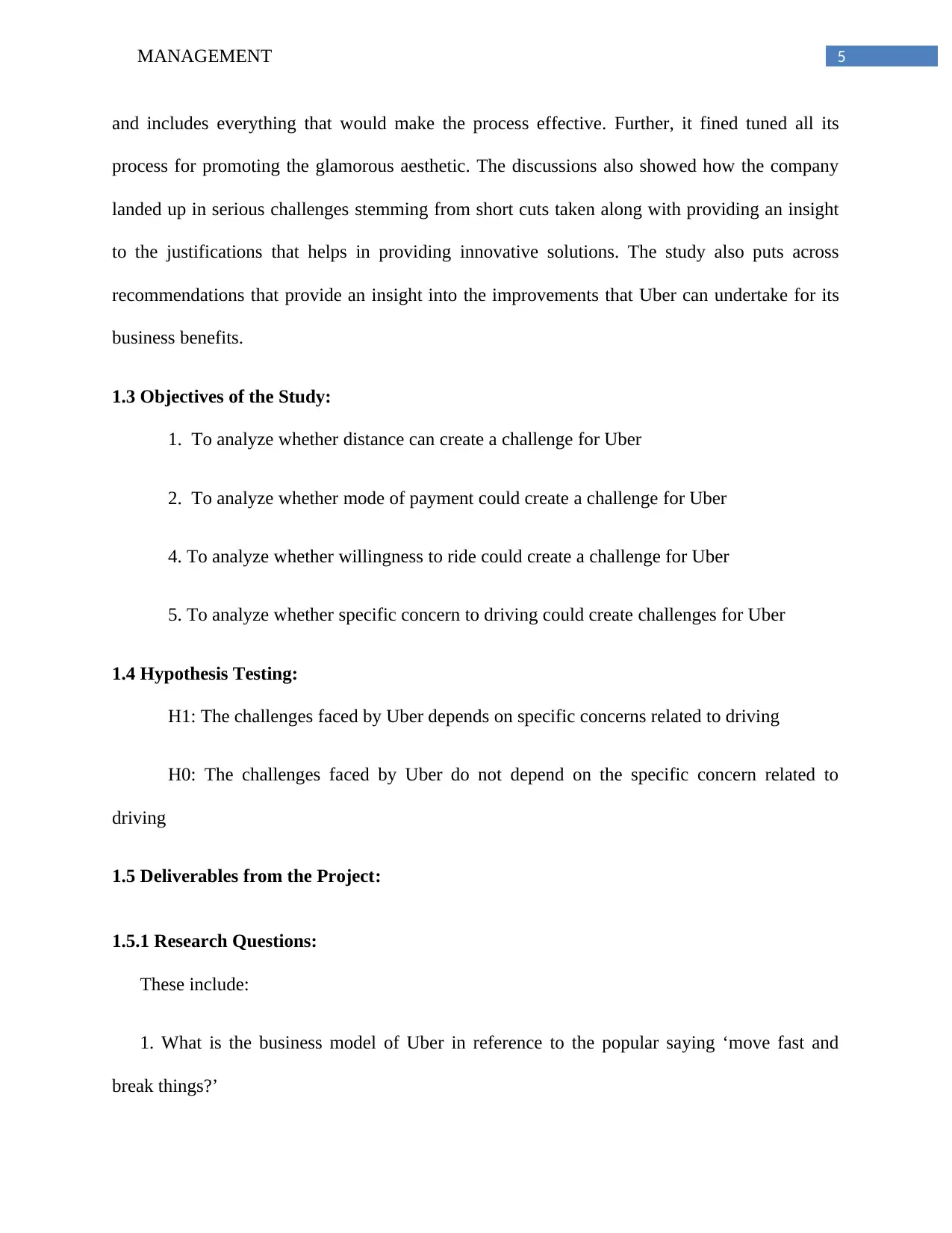
5MANAGEMENT
and includes everything that would make the process effective. Further, it fined tuned all its
process for promoting the glamorous aesthetic. The discussions also showed how the company
landed up in serious challenges stemming from short cuts taken along with providing an insight
to the justifications that helps in providing innovative solutions. The study also puts across
recommendations that provide an insight into the improvements that Uber can undertake for its
business benefits.
1.3 Objectives of the Study:
1. To analyze whether distance can create a challenge for Uber
2. To analyze whether mode of payment could create a challenge for Uber
4. To analyze whether willingness to ride could create a challenge for Uber
5. To analyze whether specific concern to driving could create challenges for Uber
1.4 Hypothesis Testing:
H1: The challenges faced by Uber depends on specific concerns related to driving
H0: The challenges faced by Uber do not depend on the specific concern related to
driving
1.5 Deliverables from the Project:
1.5.1 Research Questions:
These include:
1. What is the business model of Uber in reference to the popular saying ‘move fast and
break things?’
and includes everything that would make the process effective. Further, it fined tuned all its
process for promoting the glamorous aesthetic. The discussions also showed how the company
landed up in serious challenges stemming from short cuts taken along with providing an insight
to the justifications that helps in providing innovative solutions. The study also puts across
recommendations that provide an insight into the improvements that Uber can undertake for its
business benefits.
1.3 Objectives of the Study:
1. To analyze whether distance can create a challenge for Uber
2. To analyze whether mode of payment could create a challenge for Uber
4. To analyze whether willingness to ride could create a challenge for Uber
5. To analyze whether specific concern to driving could create challenges for Uber
1.4 Hypothesis Testing:
H1: The challenges faced by Uber depends on specific concerns related to driving
H0: The challenges faced by Uber do not depend on the specific concern related to
driving
1.5 Deliverables from the Project:
1.5.1 Research Questions:
These include:
1. What is the business model of Uber in reference to the popular saying ‘move fast and
break things?’
⊘ This is a preview!⊘
Do you want full access?
Subscribe today to unlock all pages.

Trusted by 1+ million students worldwide
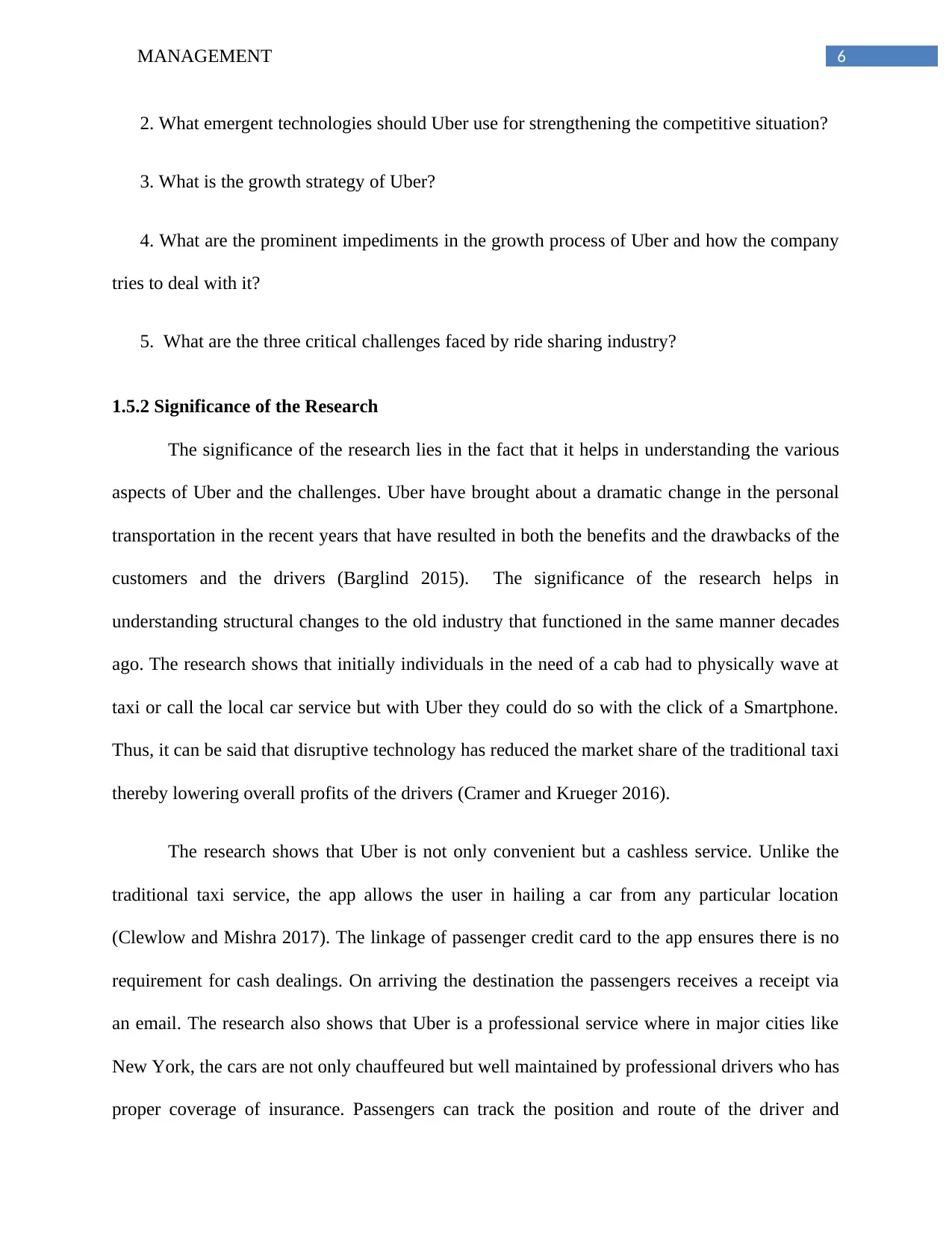
6MANAGEMENT
2. What emergent technologies should Uber use for strengthening the competitive situation?
3. What is the growth strategy of Uber?
4. What are the prominent impediments in the growth process of Uber and how the company
tries to deal with it?
5. What are the three critical challenges faced by ride sharing industry?
1.5.2 Significance of the Research
The significance of the research lies in the fact that it helps in understanding the various
aspects of Uber and the challenges. Uber have brought about a dramatic change in the personal
transportation in the recent years that have resulted in both the benefits and the drawbacks of the
customers and the drivers (Barglind 2015). The significance of the research helps in
understanding structural changes to the old industry that functioned in the same manner decades
ago. The research shows that initially individuals in the need of a cab had to physically wave at
taxi or call the local car service but with Uber they could do so with the click of a Smartphone.
Thus, it can be said that disruptive technology has reduced the market share of the traditional taxi
thereby lowering overall profits of the drivers (Cramer and Krueger 2016).
The research shows that Uber is not only convenient but a cashless service. Unlike the
traditional taxi service, the app allows the user in hailing a car from any particular location
(Clewlow and Mishra 2017). The linkage of passenger credit card to the app ensures there is no
requirement for cash dealings. On arriving the destination the passengers receives a receipt via
an email. The research also shows that Uber is a professional service where in major cities like
New York, the cars are not only chauffeured but well maintained by professional drivers who has
proper coverage of insurance. Passengers can track the position and route of the driver and
2. What emergent technologies should Uber use for strengthening the competitive situation?
3. What is the growth strategy of Uber?
4. What are the prominent impediments in the growth process of Uber and how the company
tries to deal with it?
5. What are the three critical challenges faced by ride sharing industry?
1.5.2 Significance of the Research
The significance of the research lies in the fact that it helps in understanding the various
aspects of Uber and the challenges. Uber have brought about a dramatic change in the personal
transportation in the recent years that have resulted in both the benefits and the drawbacks of the
customers and the drivers (Barglind 2015). The significance of the research helps in
understanding structural changes to the old industry that functioned in the same manner decades
ago. The research shows that initially individuals in the need of a cab had to physically wave at
taxi or call the local car service but with Uber they could do so with the click of a Smartphone.
Thus, it can be said that disruptive technology has reduced the market share of the traditional taxi
thereby lowering overall profits of the drivers (Cramer and Krueger 2016).
The research shows that Uber is not only convenient but a cashless service. Unlike the
traditional taxi service, the app allows the user in hailing a car from any particular location
(Clewlow and Mishra 2017). The linkage of passenger credit card to the app ensures there is no
requirement for cash dealings. On arriving the destination the passengers receives a receipt via
an email. The research also shows that Uber is a professional service where in major cities like
New York, the cars are not only chauffeured but well maintained by professional drivers who has
proper coverage of insurance. Passengers can track the position and route of the driver and
Paraphrase This Document
Need a fresh take? Get an instant paraphrase of this document with our AI Paraphraser
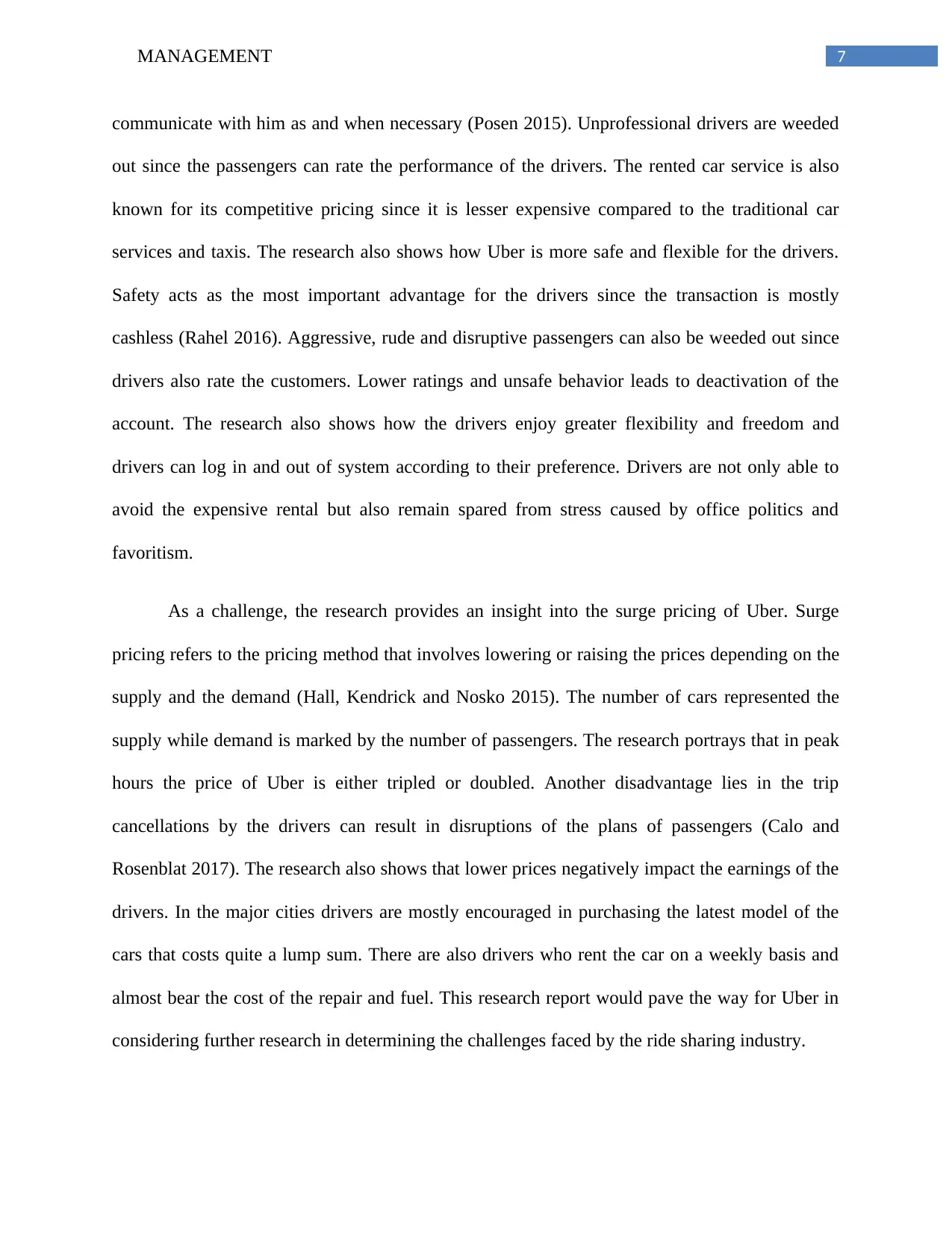
7MANAGEMENT
communicate with him as and when necessary (Posen 2015). Unprofessional drivers are weeded
out since the passengers can rate the performance of the drivers. The rented car service is also
known for its competitive pricing since it is lesser expensive compared to the traditional car
services and taxis. The research also shows how Uber is more safe and flexible for the drivers.
Safety acts as the most important advantage for the drivers since the transaction is mostly
cashless (Rahel 2016). Aggressive, rude and disruptive passengers can also be weeded out since
drivers also rate the customers. Lower ratings and unsafe behavior leads to deactivation of the
account. The research also shows how the drivers enjoy greater flexibility and freedom and
drivers can log in and out of system according to their preference. Drivers are not only able to
avoid the expensive rental but also remain spared from stress caused by office politics and
favoritism.
As a challenge, the research provides an insight into the surge pricing of Uber. Surge
pricing refers to the pricing method that involves lowering or raising the prices depending on the
supply and the demand (Hall, Kendrick and Nosko 2015). The number of cars represented the
supply while demand is marked by the number of passengers. The research portrays that in peak
hours the price of Uber is either tripled or doubled. Another disadvantage lies in the trip
cancellations by the drivers can result in disruptions of the plans of passengers (Calo and
Rosenblat 2017). The research also shows that lower prices negatively impact the earnings of the
drivers. In the major cities drivers are mostly encouraged in purchasing the latest model of the
cars that costs quite a lump sum. There are also drivers who rent the car on a weekly basis and
almost bear the cost of the repair and fuel. This research report would pave the way for Uber in
considering further research in determining the challenges faced by the ride sharing industry.
communicate with him as and when necessary (Posen 2015). Unprofessional drivers are weeded
out since the passengers can rate the performance of the drivers. The rented car service is also
known for its competitive pricing since it is lesser expensive compared to the traditional car
services and taxis. The research also shows how Uber is more safe and flexible for the drivers.
Safety acts as the most important advantage for the drivers since the transaction is mostly
cashless (Rahel 2016). Aggressive, rude and disruptive passengers can also be weeded out since
drivers also rate the customers. Lower ratings and unsafe behavior leads to deactivation of the
account. The research also shows how the drivers enjoy greater flexibility and freedom and
drivers can log in and out of system according to their preference. Drivers are not only able to
avoid the expensive rental but also remain spared from stress caused by office politics and
favoritism.
As a challenge, the research provides an insight into the surge pricing of Uber. Surge
pricing refers to the pricing method that involves lowering or raising the prices depending on the
supply and the demand (Hall, Kendrick and Nosko 2015). The number of cars represented the
supply while demand is marked by the number of passengers. The research portrays that in peak
hours the price of Uber is either tripled or doubled. Another disadvantage lies in the trip
cancellations by the drivers can result in disruptions of the plans of passengers (Calo and
Rosenblat 2017). The research also shows that lower prices negatively impact the earnings of the
drivers. In the major cities drivers are mostly encouraged in purchasing the latest model of the
cars that costs quite a lump sum. There are also drivers who rent the car on a weekly basis and
almost bear the cost of the repair and fuel. This research report would pave the way for Uber in
considering further research in determining the challenges faced by the ride sharing industry.
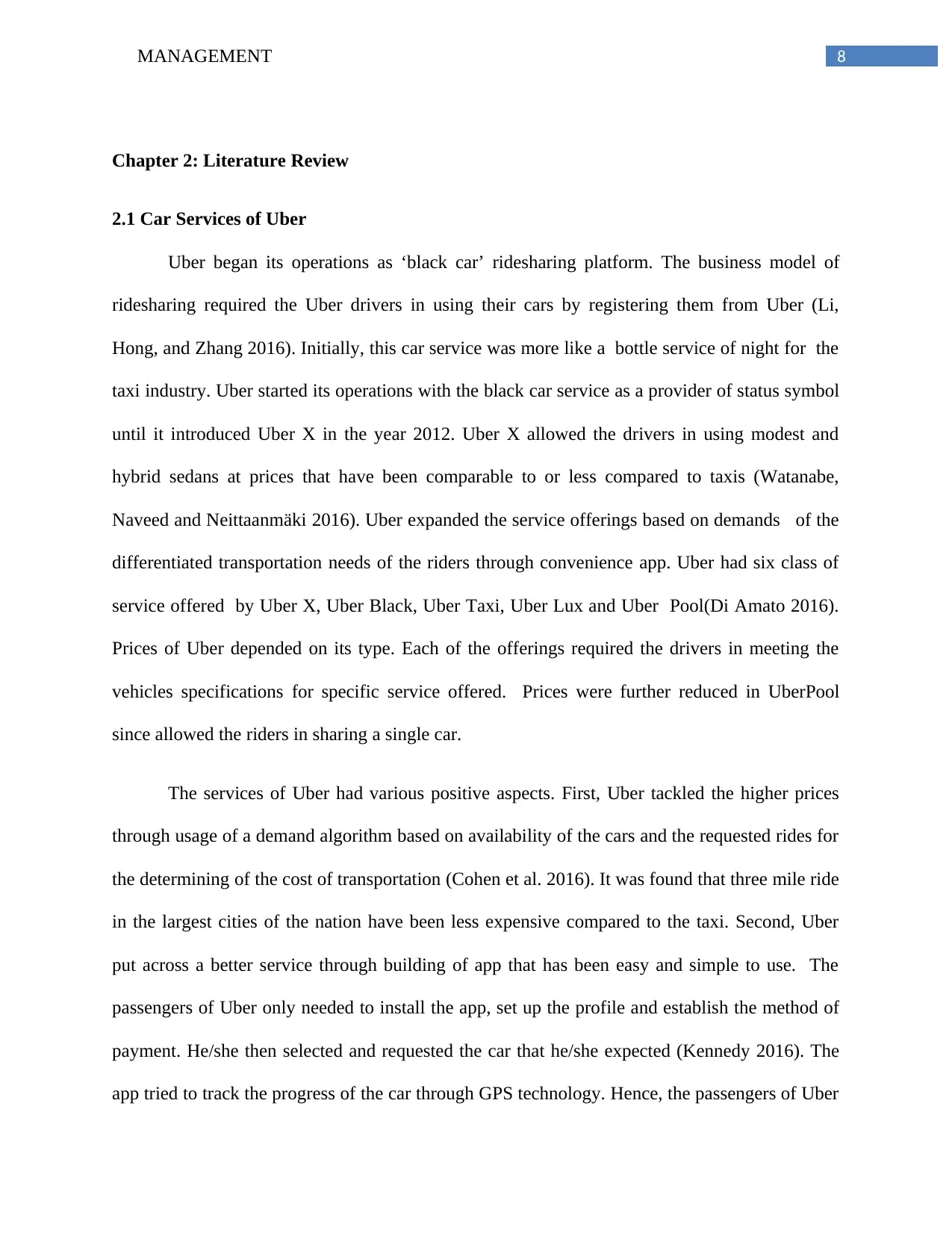
8MANAGEMENT
Chapter 2: Literature Review
2.1 Car Services of Uber
Uber began its operations as ‘black car’ ridesharing platform. The business model of
ridesharing required the Uber drivers in using their cars by registering them from Uber (Li,
Hong, and Zhang 2016). Initially, this car service was more like a bottle service of night for the
taxi industry. Uber started its operations with the black car service as a provider of status symbol
until it introduced Uber X in the year 2012. Uber X allowed the drivers in using modest and
hybrid sedans at prices that have been comparable to or less compared to taxis (Watanabe,
Naveed and Neittaanmäki 2016). Uber expanded the service offerings based on demands of the
differentiated transportation needs of the riders through convenience app. Uber had six class of
service offered by Uber X, Uber Black, Uber Taxi, Uber Lux and Uber Pool(Di Amato 2016).
Prices of Uber depended on its type. Each of the offerings required the drivers in meeting the
vehicles specifications for specific service offered. Prices were further reduced in UberPool
since allowed the riders in sharing a single car.
The services of Uber had various positive aspects. First, Uber tackled the higher prices
through usage of a demand algorithm based on availability of the cars and the requested rides for
the determining of the cost of transportation (Cohen et al. 2016). It was found that three mile ride
in the largest cities of the nation have been less expensive compared to the taxi. Second, Uber
put across a better service through building of app that has been easy and simple to use. The
passengers of Uber only needed to install the app, set up the profile and establish the method of
payment. He/she then selected and requested the car that he/she expected (Kennedy 2016). The
app tried to track the progress of the car through GPS technology. Hence, the passengers of Uber
Chapter 2: Literature Review
2.1 Car Services of Uber
Uber began its operations as ‘black car’ ridesharing platform. The business model of
ridesharing required the Uber drivers in using their cars by registering them from Uber (Li,
Hong, and Zhang 2016). Initially, this car service was more like a bottle service of night for the
taxi industry. Uber started its operations with the black car service as a provider of status symbol
until it introduced Uber X in the year 2012. Uber X allowed the drivers in using modest and
hybrid sedans at prices that have been comparable to or less compared to taxis (Watanabe,
Naveed and Neittaanmäki 2016). Uber expanded the service offerings based on demands of the
differentiated transportation needs of the riders through convenience app. Uber had six class of
service offered by Uber X, Uber Black, Uber Taxi, Uber Lux and Uber Pool(Di Amato 2016).
Prices of Uber depended on its type. Each of the offerings required the drivers in meeting the
vehicles specifications for specific service offered. Prices were further reduced in UberPool
since allowed the riders in sharing a single car.
The services of Uber had various positive aspects. First, Uber tackled the higher prices
through usage of a demand algorithm based on availability of the cars and the requested rides for
the determining of the cost of transportation (Cohen et al. 2016). It was found that three mile ride
in the largest cities of the nation have been less expensive compared to the taxi. Second, Uber
put across a better service through building of app that has been easy and simple to use. The
passengers of Uber only needed to install the app, set up the profile and establish the method of
payment. He/she then selected and requested the car that he/she expected (Kennedy 2016). The
app tried to track the progress of the car through GPS technology. Hence, the passengers of Uber
⊘ This is a preview!⊘
Do you want full access?
Subscribe today to unlock all pages.

Trusted by 1+ million students worldwide
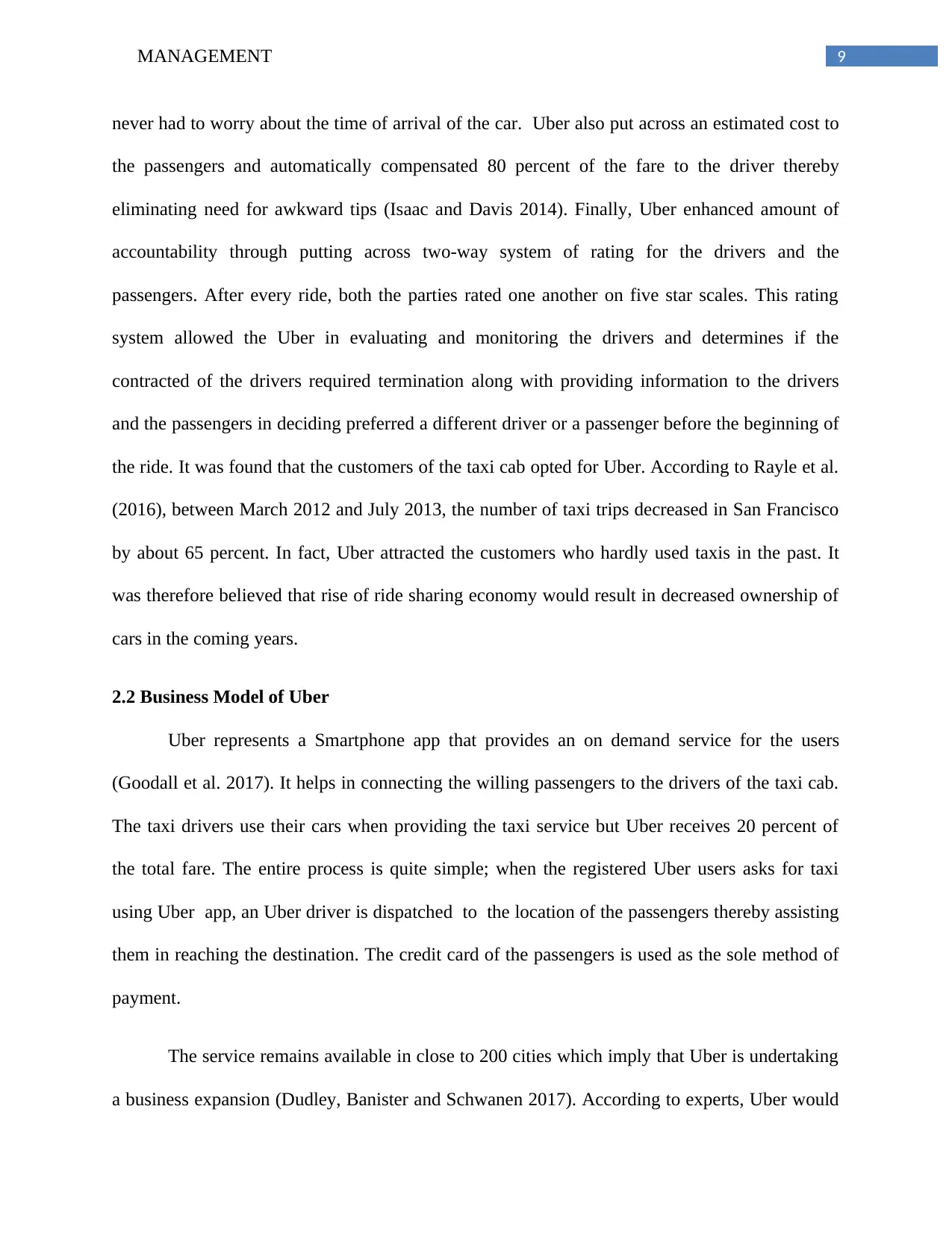
9MANAGEMENT
never had to worry about the time of arrival of the car. Uber also put across an estimated cost to
the passengers and automatically compensated 80 percent of the fare to the driver thereby
eliminating need for awkward tips (Isaac and Davis 2014). Finally, Uber enhanced amount of
accountability through putting across two-way system of rating for the drivers and the
passengers. After every ride, both the parties rated one another on five star scales. This rating
system allowed the Uber in evaluating and monitoring the drivers and determines if the
contracted of the drivers required termination along with providing information to the drivers
and the passengers in deciding preferred a different driver or a passenger before the beginning of
the ride. It was found that the customers of the taxi cab opted for Uber. According to Rayle et al.
(2016), between March 2012 and July 2013, the number of taxi trips decreased in San Francisco
by about 65 percent. In fact, Uber attracted the customers who hardly used taxis in the past. It
was therefore believed that rise of ride sharing economy would result in decreased ownership of
cars in the coming years.
2.2 Business Model of Uber
Uber represents a Smartphone app that provides an on demand service for the users
(Goodall et al. 2017). It helps in connecting the willing passengers to the drivers of the taxi cab.
The taxi drivers use their cars when providing the taxi service but Uber receives 20 percent of
the total fare. The entire process is quite simple; when the registered Uber users asks for taxi
using Uber app, an Uber driver is dispatched to the location of the passengers thereby assisting
them in reaching the destination. The credit card of the passengers is used as the sole method of
payment.
The service remains available in close to 200 cities which imply that Uber is undertaking
a business expansion (Dudley, Banister and Schwanen 2017). According to experts, Uber would
never had to worry about the time of arrival of the car. Uber also put across an estimated cost to
the passengers and automatically compensated 80 percent of the fare to the driver thereby
eliminating need for awkward tips (Isaac and Davis 2014). Finally, Uber enhanced amount of
accountability through putting across two-way system of rating for the drivers and the
passengers. After every ride, both the parties rated one another on five star scales. This rating
system allowed the Uber in evaluating and monitoring the drivers and determines if the
contracted of the drivers required termination along with providing information to the drivers
and the passengers in deciding preferred a different driver or a passenger before the beginning of
the ride. It was found that the customers of the taxi cab opted for Uber. According to Rayle et al.
(2016), between March 2012 and July 2013, the number of taxi trips decreased in San Francisco
by about 65 percent. In fact, Uber attracted the customers who hardly used taxis in the past. It
was therefore believed that rise of ride sharing economy would result in decreased ownership of
cars in the coming years.
2.2 Business Model of Uber
Uber represents a Smartphone app that provides an on demand service for the users
(Goodall et al. 2017). It helps in connecting the willing passengers to the drivers of the taxi cab.
The taxi drivers use their cars when providing the taxi service but Uber receives 20 percent of
the total fare. The entire process is quite simple; when the registered Uber users asks for taxi
using Uber app, an Uber driver is dispatched to the location of the passengers thereby assisting
them in reaching the destination. The credit card of the passengers is used as the sole method of
payment.
The service remains available in close to 200 cities which imply that Uber is undertaking
a business expansion (Dudley, Banister and Schwanen 2017). According to experts, Uber would
Paraphrase This Document
Need a fresh take? Get an instant paraphrase of this document with our AI Paraphraser
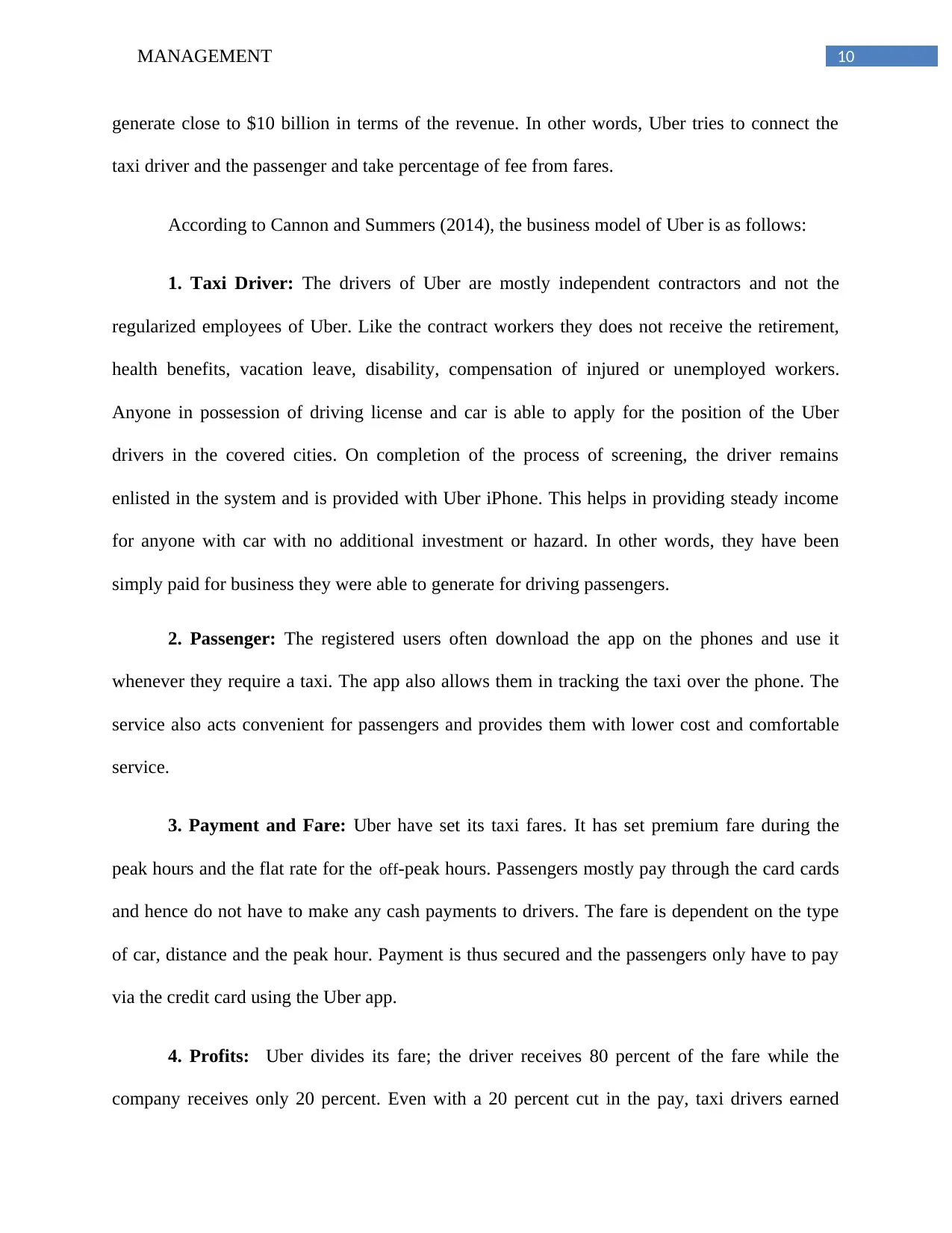
10MANAGEMENT
generate close to $10 billion in terms of the revenue. In other words, Uber tries to connect the
taxi driver and the passenger and take percentage of fee from fares.
According to Cannon and Summers (2014), the business model of Uber is as follows:
1. Taxi Driver: The drivers of Uber are mostly independent contractors and not the
regularized employees of Uber. Like the contract workers they does not receive the retirement,
health benefits, vacation leave, disability, compensation of injured or unemployed workers.
Anyone in possession of driving license and car is able to apply for the position of the Uber
drivers in the covered cities. On completion of the process of screening, the driver remains
enlisted in the system and is provided with Uber iPhone. This helps in providing steady income
for anyone with car with no additional investment or hazard. In other words, they have been
simply paid for business they were able to generate for driving passengers.
2. Passenger: The registered users often download the app on the phones and use it
whenever they require a taxi. The app also allows them in tracking the taxi over the phone. The
service also acts convenient for passengers and provides them with lower cost and comfortable
service.
3. Payment and Fare: Uber have set its taxi fares. It has set premium fare during the
peak hours and the flat rate for the off-peak hours. Passengers mostly pay through the card cards
and hence do not have to make any cash payments to drivers. The fare is dependent on the type
of car, distance and the peak hour. Payment is thus secured and the passengers only have to pay
via the credit card using the Uber app.
4. Profits: Uber divides its fare; the driver receives 80 percent of the fare while the
company receives only 20 percent. Even with a 20 percent cut in the pay, taxi drivers earned
generate close to $10 billion in terms of the revenue. In other words, Uber tries to connect the
taxi driver and the passenger and take percentage of fee from fares.
According to Cannon and Summers (2014), the business model of Uber is as follows:
1. Taxi Driver: The drivers of Uber are mostly independent contractors and not the
regularized employees of Uber. Like the contract workers they does not receive the retirement,
health benefits, vacation leave, disability, compensation of injured or unemployed workers.
Anyone in possession of driving license and car is able to apply for the position of the Uber
drivers in the covered cities. On completion of the process of screening, the driver remains
enlisted in the system and is provided with Uber iPhone. This helps in providing steady income
for anyone with car with no additional investment or hazard. In other words, they have been
simply paid for business they were able to generate for driving passengers.
2. Passenger: The registered users often download the app on the phones and use it
whenever they require a taxi. The app also allows them in tracking the taxi over the phone. The
service also acts convenient for passengers and provides them with lower cost and comfortable
service.
3. Payment and Fare: Uber have set its taxi fares. It has set premium fare during the
peak hours and the flat rate for the off-peak hours. Passengers mostly pay through the card cards
and hence do not have to make any cash payments to drivers. The fare is dependent on the type
of car, distance and the peak hour. Payment is thus secured and the passengers only have to pay
via the credit card using the Uber app.
4. Profits: Uber divides its fare; the driver receives 80 percent of the fare while the
company receives only 20 percent. Even with a 20 percent cut in the pay, taxi drivers earned

11MANAGEMENT
more compared to the traditional services of taxi. In certain cities, it was necessary for Uber to
reduce its percentage due to the competition from the similar companies like the Lyft and Haio.
5. Futuristic Growth: At the present moment, Uber does not own any taxi and hence it
is able to show higher levels of earnings in terms of the profit. Uber needed to make investment
in the research and development for the future growth. The initial reinvestment would be in
modest amount but sufficient enough in slowing down the future earnings. Besides, there would
be increase in cost due to the regulatory and the legal issues. The company has vast growth
opportunities and is believed to progress in the dozens of cities in a year.
2.3 SWOT Analysis of Uber
Strengths:
Uber app is not only user friendly but is immensely responsive with minimalistic glitches
that make the company exceptional.
Calling taxi cab with the help of Smartphone is not only easy but the passengers also
derive benefit from it
Uber did not have previous competitors in taxi service business and established
branding, consumer trust and solid infrastructure.
Weakness:
Uber has been plagued with the liability questions and the insurance issues like any other
start up services.
It faced lawsuits from the unions and the taxi companies in various bigger cities like New
York that involved the Uber in various legal battles.
more compared to the traditional services of taxi. In certain cities, it was necessary for Uber to
reduce its percentage due to the competition from the similar companies like the Lyft and Haio.
5. Futuristic Growth: At the present moment, Uber does not own any taxi and hence it
is able to show higher levels of earnings in terms of the profit. Uber needed to make investment
in the research and development for the future growth. The initial reinvestment would be in
modest amount but sufficient enough in slowing down the future earnings. Besides, there would
be increase in cost due to the regulatory and the legal issues. The company has vast growth
opportunities and is believed to progress in the dozens of cities in a year.
2.3 SWOT Analysis of Uber
Strengths:
Uber app is not only user friendly but is immensely responsive with minimalistic glitches
that make the company exceptional.
Calling taxi cab with the help of Smartphone is not only easy but the passengers also
derive benefit from it
Uber did not have previous competitors in taxi service business and established
branding, consumer trust and solid infrastructure.
Weakness:
Uber has been plagued with the liability questions and the insurance issues like any other
start up services.
It faced lawsuits from the unions and the taxi companies in various bigger cities like New
York that involved the Uber in various legal battles.
⊘ This is a preview!⊘
Do you want full access?
Subscribe today to unlock all pages.

Trusted by 1+ million students worldwide
1 out of 47
Related Documents
Your All-in-One AI-Powered Toolkit for Academic Success.
+13062052269
info@desklib.com
Available 24*7 on WhatsApp / Email
![[object Object]](/_next/static/media/star-bottom.7253800d.svg)
Unlock your academic potential
Copyright © 2020–2025 A2Z Services. All Rights Reserved. Developed and managed by ZUCOL.





